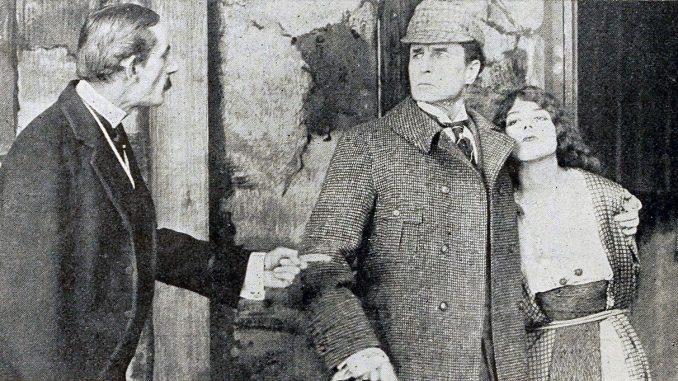
How could a classic silent film vanish from the course of history … only to turn up a century later? This is exactly what happened to the 1916 film version of Sherlock Holmes. Luckily enough for movie buffs in the Hudson Valley, the Rosendale Theatre had the opportunity to screen the unearthed footage on Sunday, Feb. 5 for their Silent Film Series.
About three years ago, a staff member of the Cinematheque in Paris, France was archiving nitrate films and happened to be working in alphabetical order, that day starting with the letter “S.” The employee came upon film cans labeled “Sherlock Holmes,” and inside contained the lost film starring William Gillette, arguably the most renowned Sherlock Holmes interpreter of his time.
Georgette Mattel, coordinator for the Sunday Silent Series and silent film lover, said the theatre has been doing the event for about four years, starting on the first Sunday of November and ending on the first Sunday of March.
“I actually really love silent films, and they don’t get a lot of show,” Mattel said. “The last really great series, which got me interested in this, was the 1970s The Silent Years.”
A gentleman had recommended Sherlock Holmes to Mattel. Knowing that the PBS series with Benedict Cumberbatch had recently aired its fourth season, she researched the film and thought it was a great idea.
She learned that the film is an adaptation of the four-act play of Sherlock Holmes written by William Gillette and Sir Arthur Conan Doyle that premiered on Nov. 6, 1899.
The restoration of the 1916 film was well done. The scenes were presented in two different colors: the indoor scenes tinted orange and the outdoor nighttime scenes colored blue. Since the film hails from the early 1900s, viewers shouldn’t expect acting of the same caliber as contemporary film. As corny as some of the special effects were — like when a lamp was thrown and the table next to it went up in flames — the film brought the character of Sherlock Holmes to life.
What was perhaps most exciting about the silent film was the improvised live piano accompaniment performance by Marta Waterman. Waterman has been doing piano accompaniment for the Rosendale Theatre since 2012 and only watches the film as preparation.
“I just sit down at the piano and whatever comes out of my fingers is what happens in the moment,” Waterman said. “Every time that I do it is different because it’s basically on the spot.”
Waterman brings her electric keyboard with a foot pedal attachment to the theatre and sits up at the front, where a pit orchestra would usually be. As the film begins to roll, so do her fingers across the keys.
For Sherlock Holmes, Waterman chose to improvise the music with a smooth jazz feel, following the movements and emotions of the characters on screen. In the film, when guns were pulled out, an accelerando, or an increase in tempo occurred; when Sherlock realizes he’s falling in love, the music softened.
“Every now and then, either while I’m driving to the theater or sitting at the piano before it starts, I can hear all of this music in my head, hear a snippet of a theme that I want to start with or just decide what key I’m going to start playing in,” Waterman said.
Waterman used a ritardando, or slowing down, to come to the completion of her performance with the film. The audience applauded her and Mattel stood up to give some background information regarding the film and announced the next silent film they will be screening.
The final silent film of the 2015-16 season will be Diary of a Lost Girl (1929) on Sunday, March 5 at 3 p.m. Tickets are $7. The Rosendale Theatre is located at 408 Main St. Rosendale, NY.
